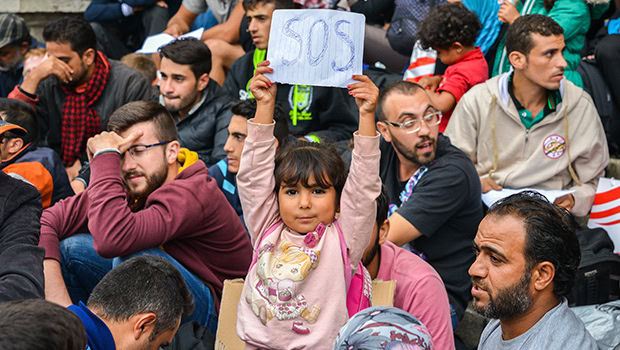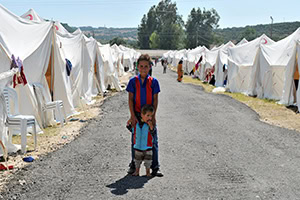Diabetes Refugees

Type 1 diabetes is trying enough for those with access to state-of-the-art medical care; it can be hard to fathom what it must be like for someone caught in a conflict zone.
And yet the suffering of refugees with Type 1 is merely a footnote in the news accounts of the latest refugee crisis, as European governments struggle to offer sanctuary to tens of thousands fleeing conflict and economic hardship in the Middle East and Africa. The world’s humanitarian organizations are being strained to the limits as they try to meet the basic medical needs of these refugees.
And those that make it to the shores of Europe are just a fraction of the total number of refugees during the crisis in the Middle East and Africa; the majority of those displaced don’t leave the borders of their countries. There are hundreds of thousands of these internally displaced refugees in Syria, for example, and they are suffering through a catastrophic disruption to their medical care. It’s reliably reported that Syria’s once-reliable health care delivery apparatus quickly disintegrated into a state of chaos soon after hostilities began between the Assad regime in power, moderate rebels, and the terror group known as ISIS.
The assault on health care delivery comes from multiple directions in conflict zones. Hospitals, pharmaceutical companies, supply warehouses, delivery routes, and delivery trucks are all targeted. Electrical and water utilities are hijacked or obliterated. The goal is to control a country’s infrastructure, or to wreck what you cannot control.
One of ISIS’ methods is to position itself defensively among non-combatants, and garrison its armed personnel in the places where innocent people congregate, like markets and hospitals. A hospital in Kunduz, Afghanistan operated by Doctors Without Borders came under fire from an U.S. HC-130 gun ship on October 3, for causes still under investigation at press time. On October 5, Doctors Without Borders left Kunduz.
Syrian health care workers who haven’t fled are being threatened by both ISIS and the Assad regime with detention and prosecution for treating rebels. Many of those needing medical care are staying away from the facilities where treatment might be available out of fear.
Those who can afford the high costs to flee include doctors and medical technicians. This exodus has grown so pronounced that ISIS has launched a video propaganda campaign to rein in the skilled professionals it needs to keep afloat its de facto government in Syria. In May, the terrorist group issued an ultimatum to doctors, support staff, and pharmacists who left Syria, threatening confiscation of their homes if they did not return to work by a June deadline. Doctors in Mosul have been forced into service as Islamic State soldiers, so that flight becomes desertion punishable by death. Doctors who don’t report to work are rounded up by armed enforcers.

T1International, a London-based diabetes care advocacy organization, has been receiving accounts of the terrors facing people displaced by war and insurrection, particularly in Syria. Elizabeth Rowley, T1International’s founder, said in a telephone interview that when war or insurrection overtakes a region it can hobble her organization’s ability to know how the burden of diabetes care is being met. Her contact with the humanitarian organizations on the ground grows difficult as communications infrastructure continues to be hijacked by terrorists or is destroyed in combat operations.
The day before she spoke with us, she had been in touch with a group that had been operating an underground emergency care facility, but then had to abandon its site due to escalation of air strikes, and fear that it would be discovered.
James Elliott, who has Type 1, has worked on health policy development for the Canadian Diabetes Association and the governments of Canada and Oman. He’s experienced in reporting on medical care delivery and in conducting field need assessments for emergency medical relief. As he wrote on T1International, while on an assignment to Lebanon he ran out of test strips and compensated by going less heavily than usual on his evening insulin dose to get through the night without fear of a low. His shortage lasted just a day. It caused him to think in stark and realistic terms, he writes, about the prospect of being unable to test regularly, or find an adequate supply of clean needles and safe insulin, and having to ration his insulin, scrounge for food suitable for a diabetic diet, or to see a doctor.
The stories of the refugee exodus can blend into a sweeping canvas of horrors, but each is an individual tragedy. There have been multiple reports of a Syrian family who resorted to using a human smuggler to carry them across the Mediterranean to Europe; the family included a girl with Type 1; some news accounts say she was 11, while others say she was 10. Offshore, the family’s belongings were ransacked and the crew sent a bag holding insulin and supplies overboard. She died two days later, her body thrown overboard.
For years the Mediterranean has been the graveyard for desperate people moving in unseaworthy vessels. Fifteen years ago, Doctors without Borders, mobilizing to assist populations of Syrians, Eritreans, and Sub-Saharan Africans seeking asylum put medical staff aboard offshore rescue vessels operated by the the Migrant Offshore Aid Station (MOAS) organization in Malta.
Those fortunate enough to reach a European shore, or to enter Europe over land, have been caught up in a puzzle palace of asylum rules. Refugees coming ashore in the south of Europe face detention not so much for illegal entry as for having no place else to go. The EU Commission appears impotent to get its member nations to cooperate to end the suffering. Displaced people arrive with undiagnosed or untreated diabetes and other chronic conditions, often without medication, and suffering from malnutrition and exposure.
Ultimately, it will require a coordinated effort among nations to stem the tide of refugees and alleviate the suffering. Until then, non-profit organizations are in dire need of donations. If you are in a position to do so, please consider giving to the following organizations:
Photo Source: Alexandre Rotenberg / Shutterstock.com
Thanks for reading this Insulin Nation article. Want more Type 1 news? Subscribe here.
Have Type 2 diabetes or know someone who does? Try Type 2 Nation, our sister publication.